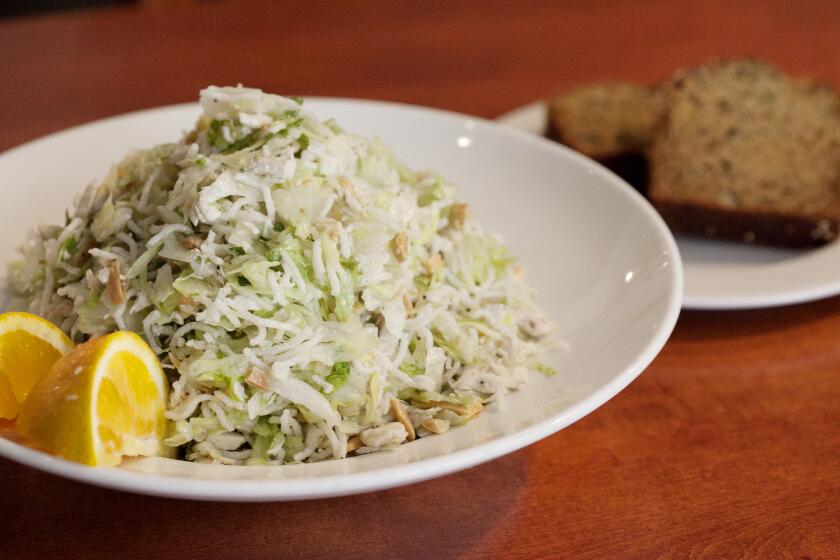Choose Among the Many Winter Squash
- Share via
Every winter squash boasts its own culinary virtues. In fact some of the newer orange pumpkin varieties have been improved for better eating quality.
Here are some delicious examples and their characteristics:
WINTER SQUASH VARIETIES
Spaghetti Squash: Nature’s exclusive design for pasta fanciers, this football-shaped squash with pale yellow shell has wide appeal for its translucent tender-crisp angel-hair strands that welcome mild pasta sauces. Cooked al dente, the squash makes a nice salad with vinaigrette-herb dressing. A lighter yellow skin indicates a sweeter pulp.
Australian Blue: Medium to large newer variety with pale bluish gray skin, sometimes with a partial shade of peach, this squash is nicely scalloped. Beneath its very tough heavy skin, is a brilliant orange meat with smooth texture. Flavor is excellent, hearty and delicious for all-purpose puree or plain baked.
Sweet Dumpling: Scalloped, this small slightly squatty, round squash has a cream colored shell with indented dark green striping. Deep yellow in color when cooked, the meaty flesh has smooth, dense texture with a pleasingly sweet flavor similar to sweet potato. Makes a beautiful natural vessel with cap sliced off and cavity filled with stuffing or sweet cream or melted butter. Use within two to three weeks; it doesn’t store as well as other varieties.
Delicata: Similar in texture, color and taste (however not as sweet) to Sweet Dumpling with just a hint of corn flavor. Also with deep-green vertical striping on its whitish shell (sometimes with orange streaks), this six- to nine-inch long, slender squash is torpedo-shaped. Squash is particularly pretty when peeled with green ribs left on; cut in scalloped circles if desired.
Gold Nugget: Small one- to two-serving orange-skinned globe with smooth, velvety meat with a deep orange color but milder flavor. Great for stuffing or pureeing for sauces and custard.
Butternut: Slightly softer rind than the average winter squash, this tan-colored, elongated gourd has a bulbous end that contains the seed cavity. Fine flavor, delicately sweet, moist pulp with yellow color. A lot of solid meat in elongated part. Butternut keeps well and sweetens with time.
Acorn, golden, white and green: Outstanding for baking. All oval-shaped with deep ridges. White variety has a delicate, blander taste, creamy color, fluffier texture than the sweeter golden and green acorns, which both have golden thick meat. Award-winning golden acorn has best flavor. Traditional green-skinned (Table Ace and Table King) are most popular.
Calabaza or West Indian Pumpkin: Large, bright yellow to orange squash with fine-grained, moist but not watery flesh. Usually sold in pieces. Adapts well to other foods when cut in chunks for vegetable casseroles. Also delicious with fresh cream. Large seeds take well to toasting.
Kabocha: Drum-shaped flattened on top with deep-green rind that’s mottled, this Japanese Buttercup strain averages two to three pounds. Flesh cooks to bright yellow-orange and is mildly sweet and mealy.
Sweet Mama: Award-winning dark green squash with golden yellow flesh--a sweeter version of kabocha squash. In general, buttercup varieties have similar dark green shells with light grayish green streaks. They’re all excellent for an all-purpose golden puree.
Baby Blue Hubbard: More practical for eating than the larger Hubbard. This round dull-blue squash has a large cavity, and is rich and flavorful with a dense, deep-yellow orange pulp.
Boston Marrow: Shaped like a Hubbard, this hybrid has a bright deep orange skin coloring with rugged texture. Size can go up to 15 pounds or more. Great for decoration and keeps well for several months.
Turk’s Turban: Although edible, this distinctively shaped gourd is grown more for its ornamental uses for Halloween and Thanksgiving. Bright brick red with streaks of green and white, it has a three-knob cap that sits on its rounded squatty base.
Banana Squash: This oversize pale yellow squash with yellow meat is often sold in cut-up pieces; convenient for slicing into chunks. Original shape is elongated with large fibrous center. Flavor is hearty and mildly sweet.
WINTER SQUASH BASICS
Buying guide: A hard tough skin (except for butternut) indicates full maturity. Look for squash that’s heavy for its size; lightweight ones will not have as much edible meaty flesh. Avoid squash with soft sunken or moldy spots, those with cuts, punctures and stems removed.
Storage: To preserve sweetness and avoid chilling injuries, do not refrigerate unless opened. Keep in cool, well ventilated dry place for one to three months, on the average and up to six months for some. Cooked pureed squash can be frozen up to six months.
Cutting: Chunks and slices may require cutting and peeling before cooking. For purees, cut in half or quarter (or leave whole if small and bake unpeeled. For large, thick-skinned squash, use a giant knife or cleaver, a wooden mallet, a good wooden board, and a little patience (pretending it’s an orange may help.)
The most difficult part is in the beginning: you cut straight across stem end, then bottom end. Use a mallet to gently hammer the top edge of the knife to ease it through the squash. Cut in half and scoop out strings and seeds with spoon. Then following the curve of the squash, slide knife under the skin and peel from top to bottom.
Smaller and softer-shelled squash may just be cut in halves with extra sharp or good serrated knife and then cleaned and baked, flesh side down on baking dish or pan. Peeled squash may also be shredded (like carrots) for breads, cakes, meat loaves, salads and cookies.
Cooking: In general, baking or microwaving are the preferred methods to obtain the best flavor and texture in a squash. Boiling tends to produce watery consistency. Wrapped in foil, halves or quarters may be cooked on the barbecue grill.
Thinly sliced dry and dense-textured squash may be fried for tempura. Aside from baked desserts and souffles, mashed or pureed squash may be used for thickening sauces and soups. For starchier squash, adapt recipes for potatoes or sweet potatoes.
To microwave: Microwave small squash whole and halve or quarter larger squash; pierce skins in several places. Cook on HIGH six to eight minutes for one pound, seven to nine minutes for two pounds with five minutes standing time. Placed on dish and lightly covered, unpeeled halved Acorn, Butternut and Spaghetti squash may be microwaved without water for 10 to 12 minutes. Small pierced whole squash may take eight to 10 minutes.
To bake: Place whole squash in baking pan and bake at 400 degrees 30 minutes to 1 1/4 hours, depending on size. Check for tenderness by piercing with fork. Cut squash may require one-third less the time and may be placed in pan with an inch of water to keep moist.
To steam or boil: Quarters or rings require 25 to 35 minutes, smaller pieces about 10 to 15 minutes. Spaghetti squash may be boiled in large kettle of boiling water for about 30 minutes or more (steaming takes longer).
To pressure-cook: Halved, unpeeled medium squash takes 6 to 7 minutes after reaching high pressure; sliced or diced squash, 3 to 4 minutes. Follow manufacturer’s directions for pressure cooking squash.
To stuff: Cut off top and core center. Slightly trim bottom so squash sits evenly. Stuff and replace top, securing with wood picks. When stuffed with meats that require an hour cooking, squash may be stuffed raw and baked at 375 degrees 1 hour; otherwise bake unstuffed squash, stuff and reheat 10 to 15 minutes.
Roasting Pumpkin Seeds: Place washed and dried seeds on baking sheet and bake at 325 degrees 20 minutes.
Yield: One to 1 1/2 pounds squash will yield three servings; one pound makes 1 2/3 to two cups cooked mashed squash.
Squash Reference Materials:
“International Produce Cookbook and Guide” by Marlene Brown (HP Books: $12.95)
“The Victory Garden Cookbook” by Marian Morash (Alfred A. Knopf: $25)
“Greene on Greens” by Bert Greene (Workman Publishing: $19.95)
“Uncommon Fruits and Vegetables” by Elizabeth Schneider (Harper and Row: $25)
“Vegetables: How to Select, Grow and Enjoy” by Derek Fall (HP Books: $7.95)
More to Read
Eat your way across L.A.
Get our weekly Tasting Notes newsletter for reviews, news and more.
You may occasionally receive promotional content from the Los Angeles Times.








